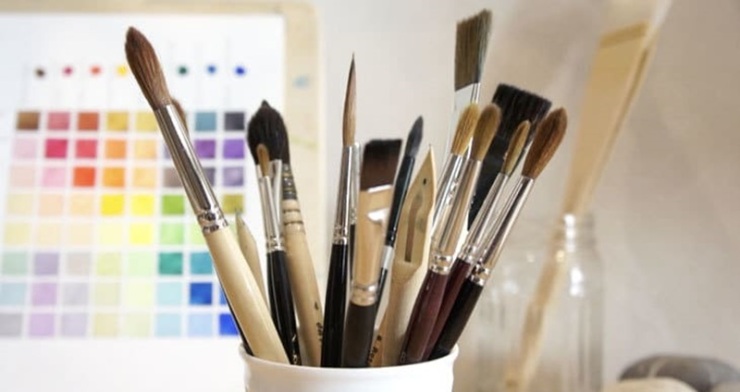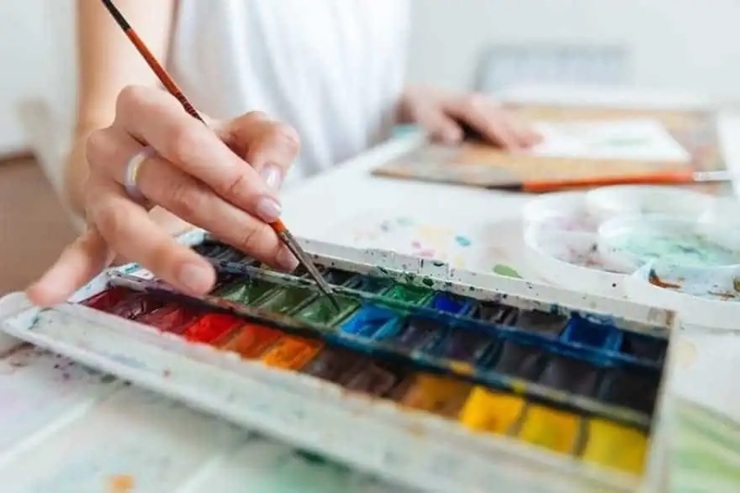In the spirit of the recent TikTok and Instagram trend – You know you’re an artist if your social media feed is full of impressive art, how-to and step-by-step videos. So here you are now, researching the essential watercolour supplies for exceptional Claude Moneau-like masterpieces. Whether you’re starting or have been creating art for some time, here’s your ultimate guide to the world of watercolours.
What Materials Do You Need for Watercolor Painting?
If you can’t wait to start watercolour, the good news is that you don’t need many supplies, making it an affordable pastime. However, you still need essential watercolour painting materials, such as paints, paper, paintbrushes, a container of water, a palette and soap.
Paints
There are two types of watercolour paint: tubes and pans. Watercolour tubes have a pasty quality and are already damp. Watercolour pans are like hard paint cakes; you must wet them with water to use them.
You can buy watercolour paints in sets or singly. Consider purchasing a beginner’s set with pans and tubes to see which quality you like if you can’t decide which to get. It truly comes down to your own experience with either, as every artist has different preferences regarding pans vs. tubes!
Also, watercolour paints come in two quality levels: student and artist standard. While the student-quality watercolours are less expensive than the artist-quality ones, they’re less pigmented and more filled in. Essentially, you receive what you pay for. You can obtain more magnific colour and transparency subtlety by using artist-quality watercolours.
However, student-grade watercolours will offer novices a taste of watercolour painting; if you think you’ll enjoy it, you can always get a set of artist-grade watercolours later!
Paintbrushes

There are three things to consider when purchasing watercolour brushes: shape, size, and hair. Here’s the essential info that you need to know.
If you only have the means to purchase one brush, go for a natural round brush because they’re superior to synthetic ones. Invest in a small and a medium round brush (or a medium and a large round, depending on whether you prefer to work large or small) if you can afford two. You’ll be glad to hear that all it takes to complete a watercolour painting is one brush if you’re on a tight budget! I’ve used a little round brush to accomplish this many times. Here are more factors to consider if you’re ready to dive deeper into watercolour paintbrushes.
Hair. Although natural hair paintbrushes are the most excellent option for watercolour painting, they can be relatively expensive. The most prized hair kind is sable, particularly Kolinsky Sable. Kolinsky Sable brushes have robust hairs that, with proper maintenance, can last a lifetime. Paintbrushes made of red and pure sable are still reasonably excellent, although they’re more affordable than Kolinsky Sable.
Other hair kinds used to make watercolour brushes are ox hair, which works well for making huge washes; squirrel hair, which works well for mop brushes; and ox hair, which is perfect for square brushes.
Size. The size of watercolour brushes ranges from tiny to moderately large. Watercolour brushes are very adaptable, as you will see from the explanations of each brush type. It’s great to have a variety of sizes, but you don’t need that many. For example, a medium or large round brush works well for fine detail work and broad colour washes; you may use the same brush for both tasks.
Shape. There are various forms and purposes for watercolour brushes:
- Angular. Named by their angle of cutting, the hairs are angular. Suitable for filling medium-sized colour blocks as well as precise brushwork.
- Mop. Excellent for rapidly soaking oversized sections of paper and applying colour.
- Liner. That is a thin, sharp brush used to apply small details.
- Round. That’s the ideal “all-around” brush; any watercolour painting kit should include a round brush! You can use the circular brush for washes as well as detailing. By altering your angle, you may adjust the width of your lines.
Watercolour Paper
Paper is one of the most crucial watercolour painting materials. You can buy watercolour paper in sheets, pads, or blocks. Student and artist papers are available. Because artist papers are of higher quality, ensure to buy such to create outstanding masterpieces.
- Sheets. You can buy individual artist-quality watercolour paper sheets and cut them to the desired size. That’s a helpful method for experimenting with various paper types.
- Pads. These typically include student-quality watercolour paper bound together on one edge with wire. Generally, watercolour pads come with 10–20 much fewer sheets than you could buy separately. These are practical for practice as well as travel!
- Blocks. Watercolour blocks are just stacks of paper joined at one end with glue. After painting the top sheet, gently remove your page by inserting a knife into the glued binding and letting it dry.
One thing regarding watercolour papers is that they come in rough, cold-pressed, and hot-pressed varieties. Most watercolour artists work with cold-pressed or rough paper.
Palette

Pottery or plastic make up the majority of watercolour palettes. Paint ultimately stains plastic palettes; nonetheless, plastic palettes are lighter and more convenient to handle. Ceramic palettes are of higher quality.
Pick a palette with distinct wells where you can blend your colours. The walls will prevent the dyes from blending, as the wet paint might otherwise. You may also use the plastic watercolour set lid as a palette for pan watercolours. Just make sure that when you close it, the lid is dry. Tin foil or a dinner plate works well as makeshift palettes. Ensure the colours have enough room to separate so they don’t run into each other.
Water Container
Water in a glass, container, or cup is necessary. To see how clean or unclean the water is, it’s ideal if your container is transparent. When the water gets too murky, it’s crucial to replace it because otherwise, the residue could collect on your brush and end up on your painting. Some artists use two pots of water: one for rinsing between colours and one with clean water for dipping.
Soap
Use an organic, all-natural soap or a light shampoo to clean your watercolour brushes. Steer clear of commercial soaps with strong cleansers since they may cause damage to your brush’s hair.